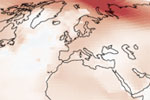The Cryosphere by Dr. Shawn J. Marshall, Canada Research Chair in Climate Change, University of Calgary, is an excellent book because it summarizes leading scientific
research into easily accessible chapters each one on a different component of the cryosphere. The cryosphere, which incorporates the Earth’s snow and
ice mass including seasonal snow, permafrost (both land-based permafrost and below water permafrost), river and lake ice, sea ice, glaciers, ice
sheets, and ice shelves, is intrinsically related to global climate change. Hence, understanding how the cryosphere interacts with and is at risk
because of climate change and its greenhouse gases is fundamental to developing effective policy mechanisms that mitigate climate change.
The Cryosphere
contains clear and concise chapters each on snow and ice material properties and thermodynamics; different types precipitation including seasonal snow,
freshwater ice, sea ice, permafrost, glaciers and ice sheets; and summary chapters the cryosphere’s climate processes and on a global climate change
impacted Earth. Each chapter includes definitive easy to follow mathematical equations, illustrative examples, anecdotes, and notes for further
reference. The book also contains a helpful glossary.
For example, roughly 35 percent of the Earth’s geography experiences freezing points seasonally throughout the year. And these freezing points globally
impact the cryosphere resulting in a tight feedback loop between the cryosphere and temperatures associated with global warming. This is an example of
the critical importance of the cryosphere on a global climate change impacted Earth.
The most reflective surfaces of the Earth are snow and ice, which are only secondary in their impact behind clouds on the Earth’s albedo. This means
that snow and ice cover have significant impact on global climate change and the Earth’s energy budget resulting in describing the Earth’s ice as a
latent energy buffer.
Finally, it is critical for stakeholders to support applied research that provides answers describing the interactions within cryosphere-climate
processes and the cryosphere’s sensitivity to global climate change because the Earth’s political and geographic atlas, under a climate change impacted
world, will be redrawn in the near-term with impacted navigable waterways, political and coastal boundaries, river systems, and ecosystems.
The Cryosphere
is part of Princeton Primers in Climate, a series of precise and state-of-the-art
authoritative books that explain the current state of climate science research. These authoritative, short books are written specifically for
stakeholders, students, researchers, and scientifically oriented general readers needing precise, easy-to-read resources on global climate change and
climate science. These books at Princeton Primers in Climate are a superb resource to find meticulous, detailed, and clearly presented facts on
climate change science.
In summary, I very much enjoyed reading this book.
How to order:
The Cryosphere
Paperback: 288 Pages
Publisher: Princeton University Press
ISBN: 9780691145266
Authors: Dr. Geoffrey K. Vallis
Gabriel Thoumi, CFA is a frequent contributor to Mongabay.com.
Related articles
NASA: 2011 ninth warmest year yet

(01/23/2012) Despite being a strong La Niña year, which tends to be cooler than the average year, 2011 was the ninth warmest year on record and the warmest La Niña yet, according to a global temperature analysis by NASA. To date, nine of the world’s ten warmest years have occurred since 2000 according to data going back to 1880.
Deforestation, climate change threaten the ecological resilience of the Amazon rainforest
(01/19/2012) The combination of deforestation, forest degradation, and the effects of climate change are weakening the resilience of the Amazon rainforest ecosystem, potentially leading to loss of carbon storage and changes in rainfall patterns and river discharge, finds a comprehensive review published in the journal Nature.
Targeting methane, black carbon could buy world a little time on climate change

(01/12/2012) A new study in Science argues that reducing methane and black carbon emissions would bring global health, agriculture, and climate benefits. While such reductions would not replace the need to reduce CO2 emissions, they could have the result of lowering global temperature by 0.5 degrees Celsius (0.9 degree Fahrenheit) by mid-century, as well as having the added benefits of saving lives and boosting agricultural yields. In addition, the authors contend that dealing with black carbon and methane now would be inexpensive and politically feasible.